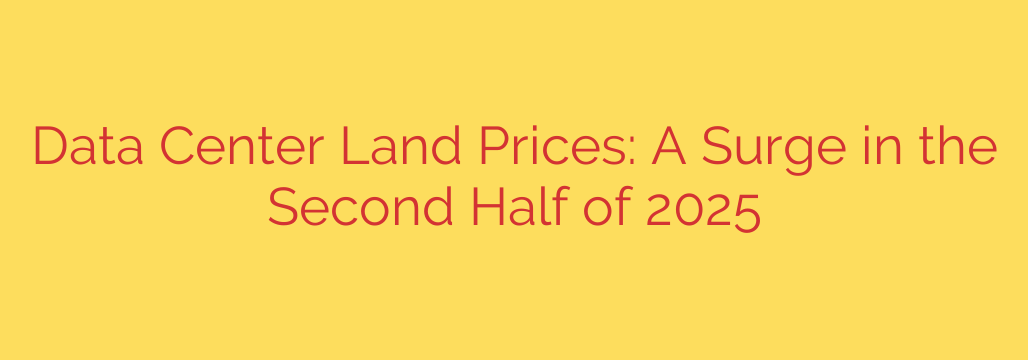
Navigating the Surge: Why Data Center Land Prices Are Set to Skyrocket in 2025
The digital world runs on a physical foundation—sprawling, power-hungry buildings known as data centers. For years, the acquisition of land for these critical facilities was a predictable part of the development process. However, a perfect storm of technological advancement and market demand is brewing, and it’s poised to send land prices into overdrive.
The market is flashing clear signals: a significant surge in land prices for data center development is anticipated, with the acceleration expected to hit full force in the second half of 2025. This isn’t a minor market fluctuation; it’s a fundamental shift driven by unprecedented demand that is rapidly outstripping the supply of suitable sites.
For investors, developers, and enterprise users, understanding the forces behind this trend is crucial for navigating the challenging landscape ahead.
The Driving Forces Behind the Price Explosion
This impending land rush is not happening in a vacuum. It’s the direct result of several powerful, converging trends that are reshaping our digital infrastructure.
The Insatiable Demand of Artificial Intelligence: The single biggest catalyst is the AI boom. Training and running large language models (LLMs) and other AI workloads require immense computational power. This translates directly into a need for massive, high-density data centers that consume enormous amounts of energy. Companies are racing to build the specialized infrastructure needed to power the AI revolution, putting immense pressure on land with access to robust power grids.
Relentless Cloud Expansion: Hyperscale cloud providers like Amazon Web Services (AWS), Google Cloud, and Microsoft Azure are in a constant state of expansion. As more businesses migrate their operations to the cloud and digital services become more integrated into our daily lives, these giants must continuously build new availability zones and regions, consuming vast tracts of land in the process.
The Scarcity of “Goldilocks” Locations: Not just any piece of land will do. A prime data center location requires a specific set of attributes:
- Massive Power Availability: Access to multi-megawatt power substations is non-negotiable.
- Robust Fiber Connectivity: Proximity to dense, redundant fiber optic networks is essential for low-latency performance.
- Favorable Zoning and Permitting: Local governments must be willing and able to approve these large-scale industrial projects.
- Low Risk of Natural Disasters: Locations must be secure from floods, earthquakes, and other environmental threats.
As demand skyrockets, the inventory of these “Goldilocks” sites in established markets is dwindling fast, turning the search for suitable land into a highly competitive and costly endeavor.
Market Hotspots and Projections
While this is a global phenomenon, the pressure is most acute in primary data center markets. Traditional hubs like Northern Virginia (Data Center Alley), Phoenix, Dallas, and Chicago are experiencing intense competition for land parcels with available power. Similar trends are emerging in key European markets like Frankfurt, London, Amsterdam, and Dublin.
The core projection is that developers who are currently in the planning and power-application phase will move to the land acquisition stage throughout 2024 and early 2025. This wave of purchasing activity is expected to trigger a sharp price escalation in the latter half of 2025, catching many by surprise.
Actionable Strategies: How to Prepare for the Land Rush
The rising cost of land has a direct ripple effect, leading to higher development costs, longer project timelines, and potentially increased prices for end-users of cloud and colocation services. Proactive planning is the only way to mitigate these challenges.
Here are essential strategies for businesses looking to secure their digital future:
Secure Land and Power Early: For organizations with a long-term data center strategy, the time to act is now. “Land banking”—acquiring suitable parcels of land years before they are needed—is becoming a critical competitive advantage. This is especially true for securing power capacity agreements from utility providers, which are often a bigger constraint than the land itself.
Explore Emerging Markets: As primary markets become saturated and prohibitively expensive, developers are increasingly looking to secondary and tertiary markets. These locations may offer lower land costs and more readily available power, provided they have sufficient fiber connectivity. Conducting thorough due diligence on these emerging hubs can uncover significant opportunities.
Prioritize Vertical Construction: The days of single-story, sprawling data center campuses may be numbered in land-constrained areas. Adopting multi-story designs is a key strategy to maximize the capacity of a given land parcel. This approach, while more complex from an engineering perspective, drastically improves land use efficiency.
Partner with Market Experts: Navigating the complex interplay of real estate, power utilities, and local regulations requires specialized knowledge. Working with brokers and consultants who focus exclusively on data center site selection can provide invaluable insights and access to off-market opportunities.
The era of easily acquired, affordable land for data center development is rapidly coming to a close. The market is fundamentally shifting, driven by the seismic demands of AI and continued cloud growth. Success in this new environment will belong to those who think strategically, act decisively, and plan far into the future.
Source: https://www.datacenters.com/news/data-center-land-deals-why-prices-are-skyrocketing-in-2025-s-second-half








